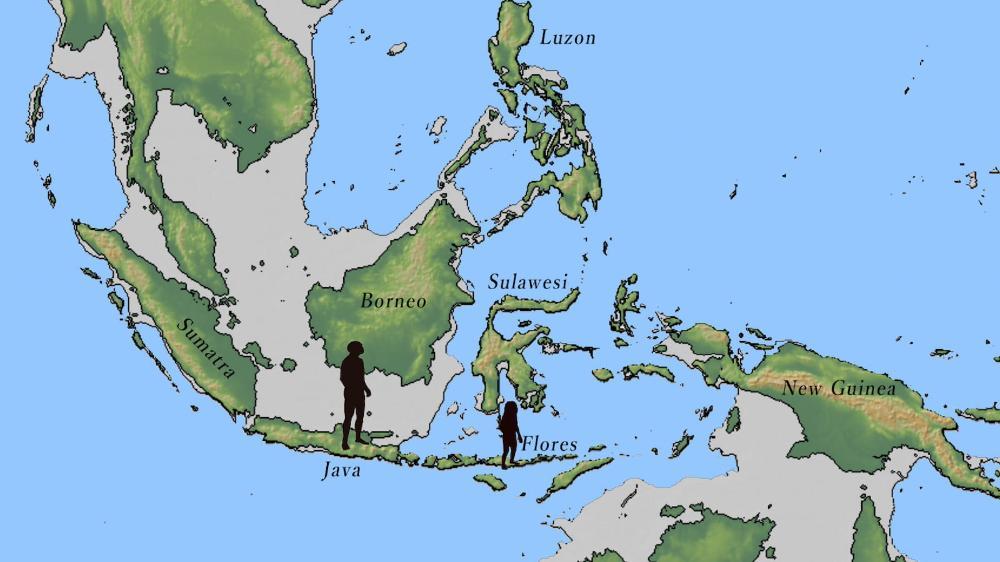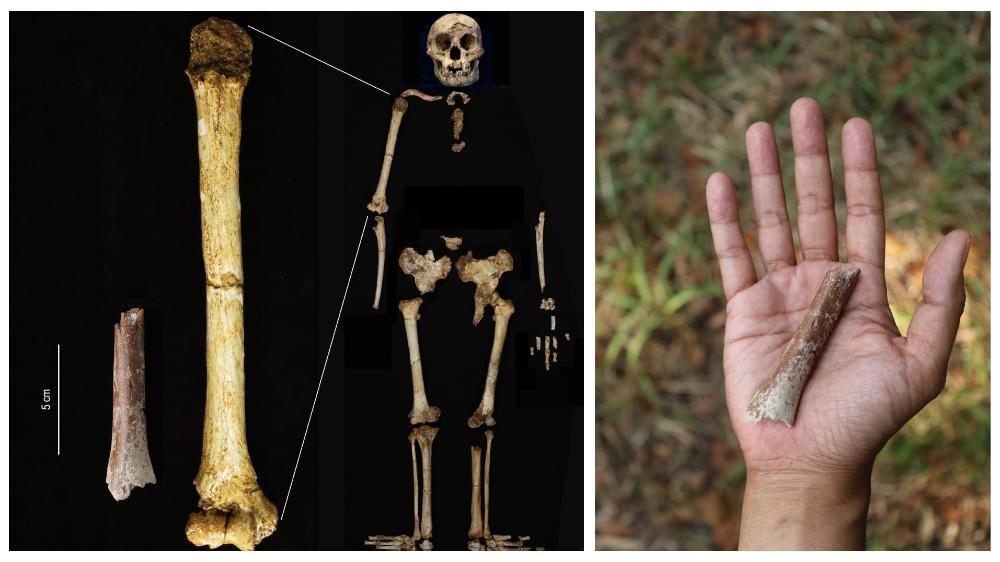August 7, 2024
Remarkable fossil discovery sheds new light on ‘the Hobbit’s’ ancestors
Evolution of extremely small body size in Homo floresiensis occurred 700,000 years ago on the island of Flores
The discovery of the smallest adult limb bone on fossil record has expanded researchers’ understanding of the evolution of the archaic Homo floresiensis and its ancestors, who lived approximately 700,000 years ago on the Indonesian island of Flores, suggesting that their body sizes were even smaller than previously thought.
An international team of researchers, co-led by Dr Gerrit (Gert) van den Bergh from the Centre for Archaeological Science at the University of Wollongong (UOW), recovered an adult humerus – the lower half of the upper arm bone – from securely dated stratum at the Mata Menge excavation site in the So’a Basin in Flores. The finding was revealed in a peer-reviewed paper released in Nature Communications this week (7 August), titled ‘Early evolution of extremely small body size in Homo floresiensis’, uncovering new insights into the family tree of the petite early humans.
Based on the estimated length of the humerus, approximately 211 and 220mm, the researchers were able to calculate the body height of this early human to be between 103 and 108cm tall. When using the same method based on humerus length, this is approximately 6 to 13 cm shorter than the estimated body height of Homo floresiensis, the diminutive hominin which was dated to have lived around 60,000 years ago.
The discovery builds on decades of groundbreaking research from UOW into the Homo floresiensis, the remains of which were first uncovered in 2003 in Liang Bua cave on Flores, an island in eastern Indonesia. Homo floresiensis, initially found in 60,000-year-old stratum, had an estimated height of only 106cm (an estimate based on femoral length), which sparked international scientific interest in the evolution of such small-bodied hominins. The fossil find was dubbed the ‘Hobbit’ due to its tiny stature and radically challenged the prevailing theories of human evolution and dispersal across the globe.
Ten years later, the Mata Menge excavation site in the So’a Basin of Flores was found to contain archaic human teeth, both of young and old individuals, and a fossil jaw that was not just smaller than the Homo floresiensis holotype, but considerably older – predating the Liang Bua hominins by 650,000 years.

The size of the hominins on the island of Flores compared to those on neighbouring Java, both in Indonesia.
Digital microscopy of the microstructure indicates that the small humerus is from an adult and is the smallest of the known human (hominin) fossils in terms of its thickness and reconstructed length.
The humerus is part of 10 fragments of human fossils found at the Mata Menge excavation site, which are taken from at least four individuals, including two children.
The research further captures the similarities between the Homo floresiensis and Homo erectus recovered from the nearby Indonesian island of Java. It strengthens the hypothesis that the ancestors of Homo floresiensis were the large-bodied Javanese Homo erectus, who were as big as modern humans. Stone tools recovered from the So’a Basin suggests that Homo erectus became isolated on the island of Flores around 1 million years ago and underwent a dramatic reduction in body size over the following 300,000 years.
Dr van den Bergh said the most recent painstaking findings offered a wealth of evidence regarding the ancestors of Homo floresiensis and how their diminutive body size came to be.
“Initially, we didn’t recognise the humerus fragment, which was broken in several pieces, as belonging to a hominin, because we expected that the toolmaker at Mata Menge would be a large-bodied Homo erectus. But after painstaking reconstruction by curator Indra Sutisna, the fossil was recognised as a hominin distal humerus fragment, and a very small one for that matter,” Dr van den Bergh said.
“Every tooth, mandible, and humerus belonging to at least two individuals for which comparisons can be made, are smaller than those of Liang Bua. This means that 700,000-years-ago Homo floresiensis was at least as small as, or even slightly smaller than, the 60,000-years-old Homo floresiensis from Liang Bua.
“This research adds further evidence of the similarity of Homo floresiensis to Homo erectus. It does not support the alternative hypothesis that Homo floresiensis evolved from a smaller, more primitive Australopithecus [a group of early hominins that existed in Africa during the Pliocene and Early Pleistocene] or Homo habilis [a species of archaic human], neither of which have ever been discovered in Indonesia or the wider Asian region.”

The adult humerus discovered in Flores. Photos: Gert van den Bergh
Dr Yousuke Kaifu from the Department of Anthropology, National Museum of Nature and Science, Tokyo and colleagues from Japan analysed the fossil hominin material.
“When I first saw the small humerus, I thought it was a child's bone, but I became curious and was surprised when I looked up its developmental stage. The task of estimating the age and length was difficult, but through collaboration with my co-researchers, we were able to solve the problems to produce these results,” he said.
At the time of the existence of the Homo floresiensis, the island of Flores was also inhabited by Stegodon (a extinct small type of elephant), rats of varying sizes, crocodiles and Komodo dragons, which could grow up to three metres in length. Dr van den Bergh said the co-existence of these species suggests the reptilian predators were not a significant threat to the population to Homo floresiensis.
“It appears that the early dramatic reduction and subsequent stability of body size of the archaic Homo populations suggests that having a smaller body on this isolated island benefited their ability to survive,” Dr van den Bergh said.
Homo floresiensis disappears from the fossil record around 50,000 years ago, which is when modern humans (Homo sapiens) first appear in the record.
About the research
‘Early evolution of extremely small body size in Homo floresiensis’, by Yousuke Kaifu, Iwan Kurniawan, Soichiro Mizushima, Junmei Sawada, Michael Lague, Ruly Setiawan, Indra Sutisna, Unggul P Wibowo, Gen Suwa, Reiko T Kono, Tomohiko Sasaki, Adam Brumm, Gerrit D van den Bergh, was published in Nature Communications: https://www.nature.com/articles/s41467-024-50649-7
The So’a Basin Research Project is sponsored by the Australian Research Council and co-led by Gerrit van den Bergh at UOW and Ruly Setiawan and Iwan Kurniawan from the Geological Survey Centre, Geological Agency, Bandung, in collaboration with the Centre for Prehistoric Archaeology and History Research, National Research and Innovation Agency, Jakarta, Indonesia and a team of international researchers.
:format(jpg)/prod01/channel_3/assets/media-centre/UOWAUG6-26.jpg)